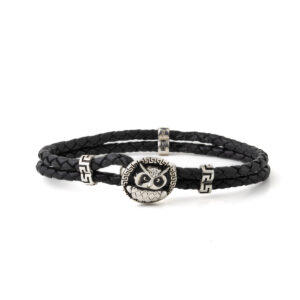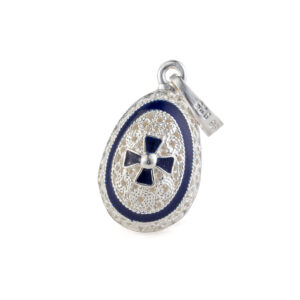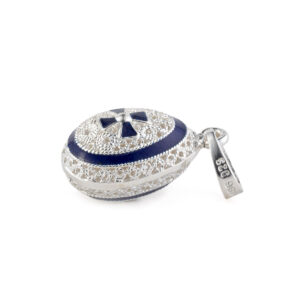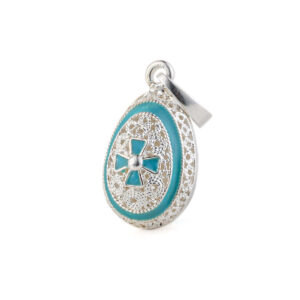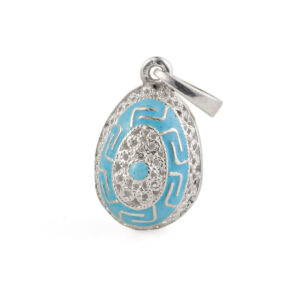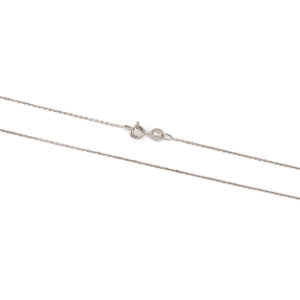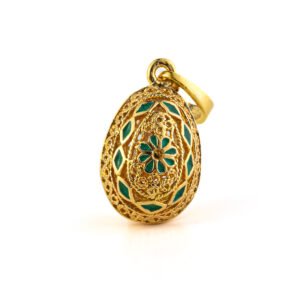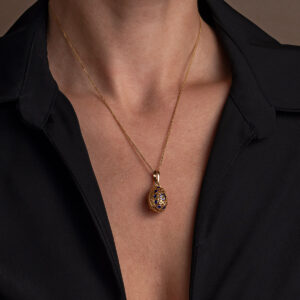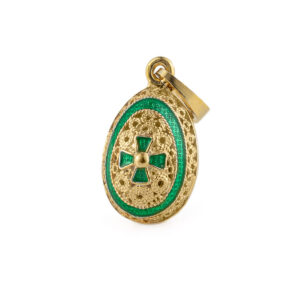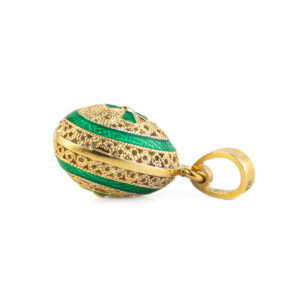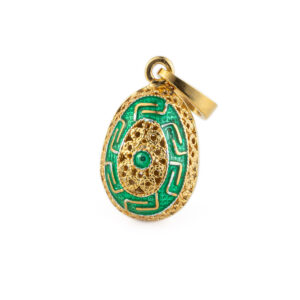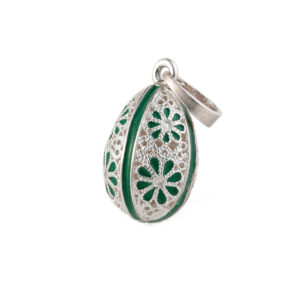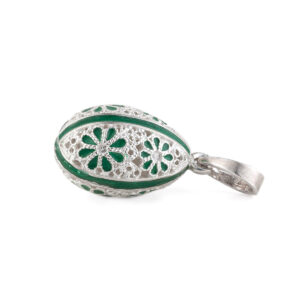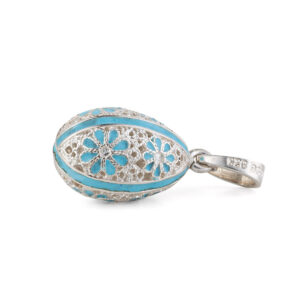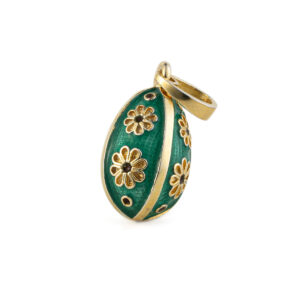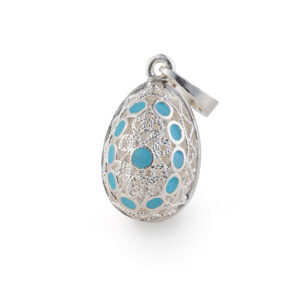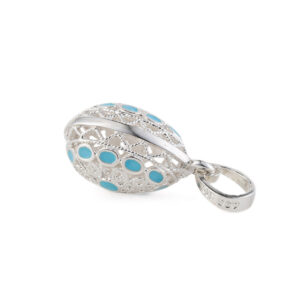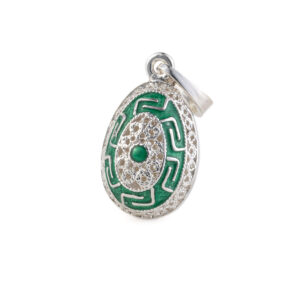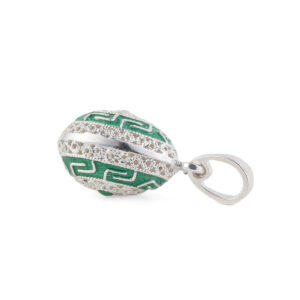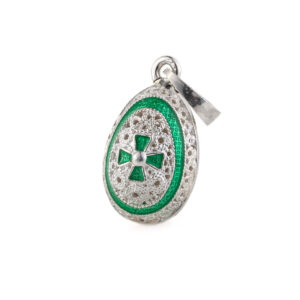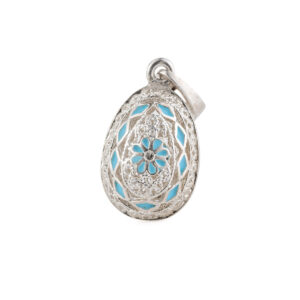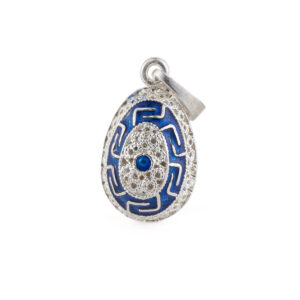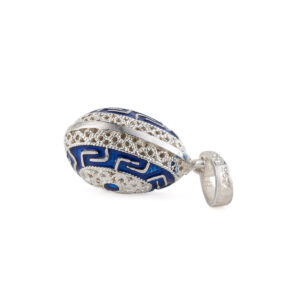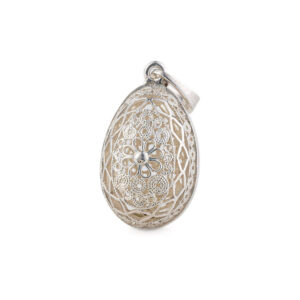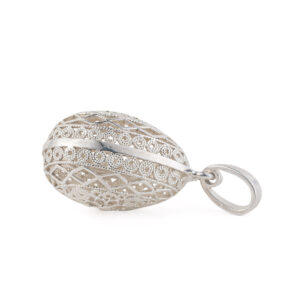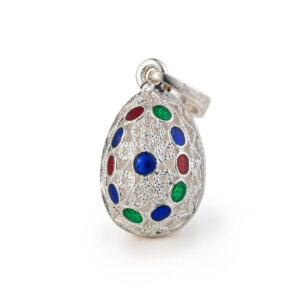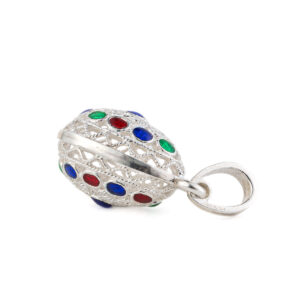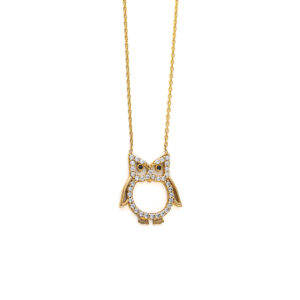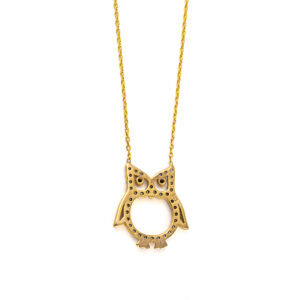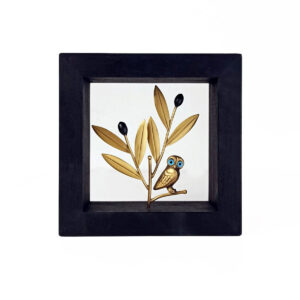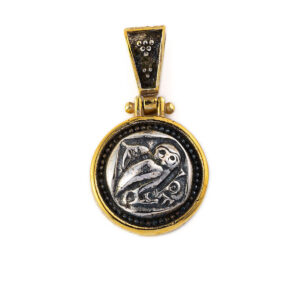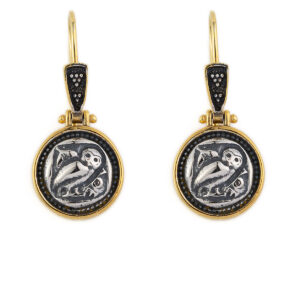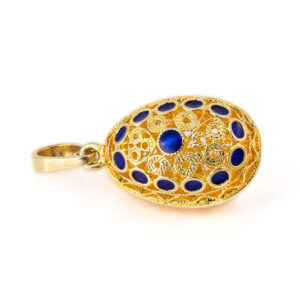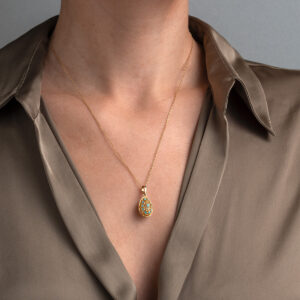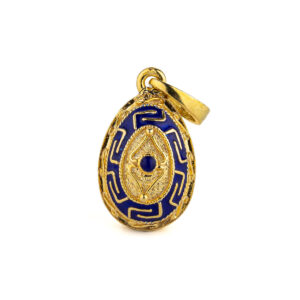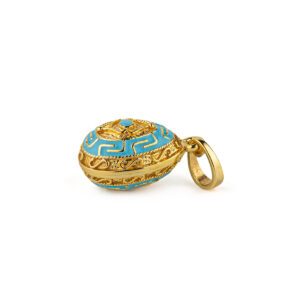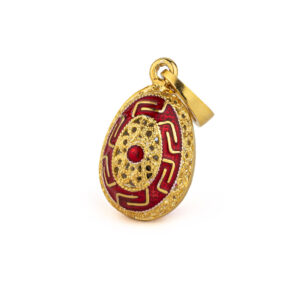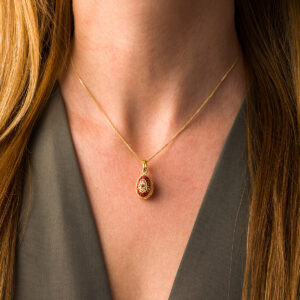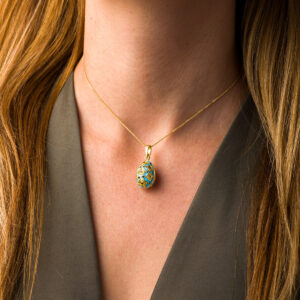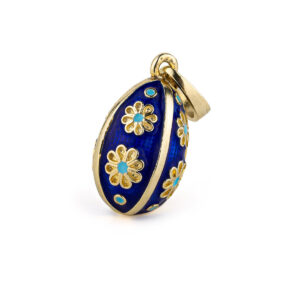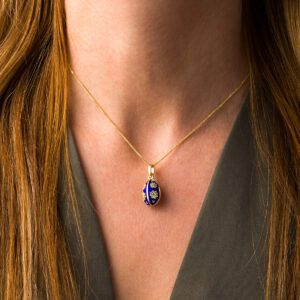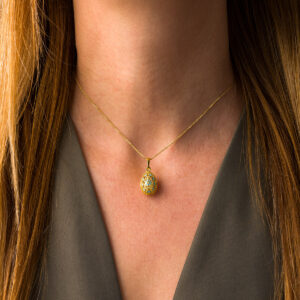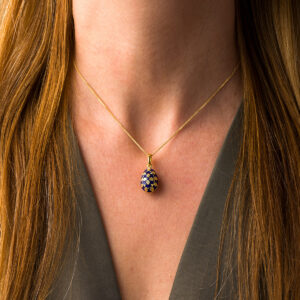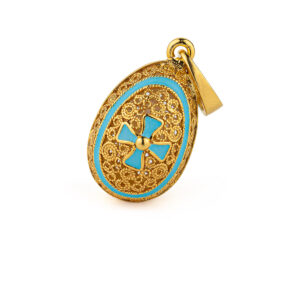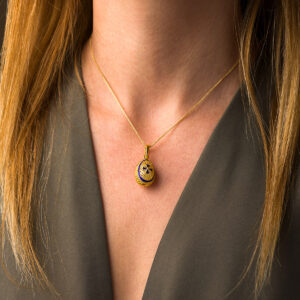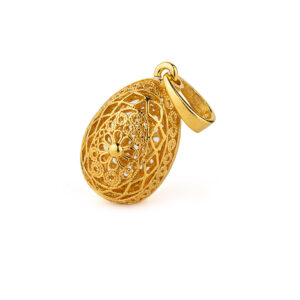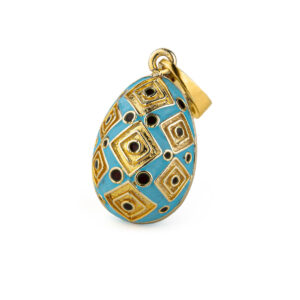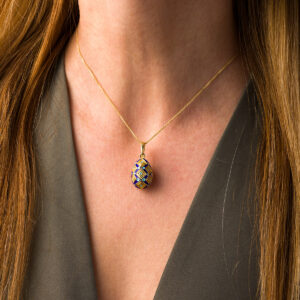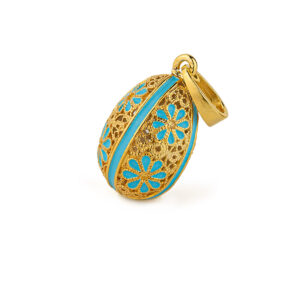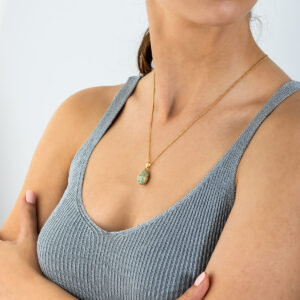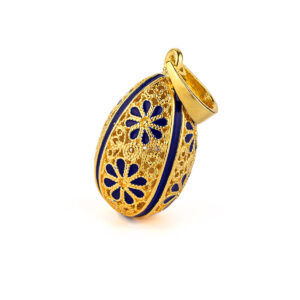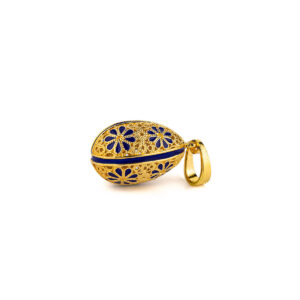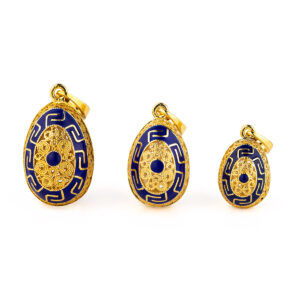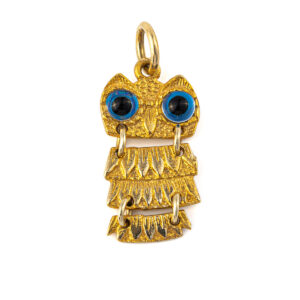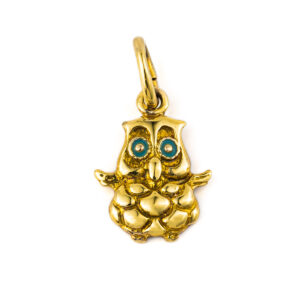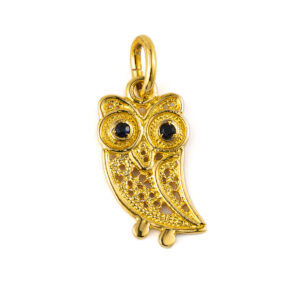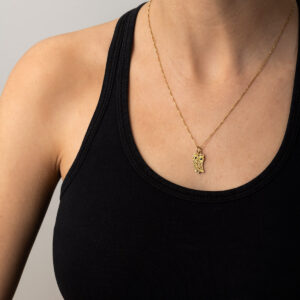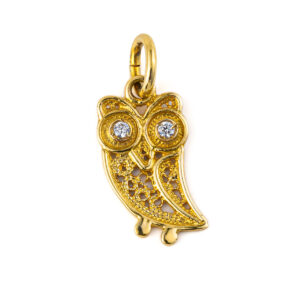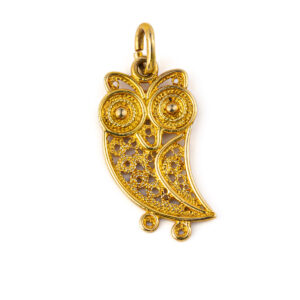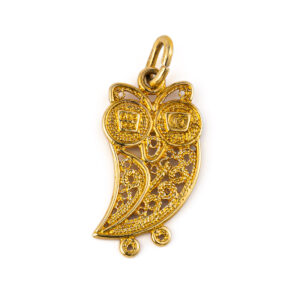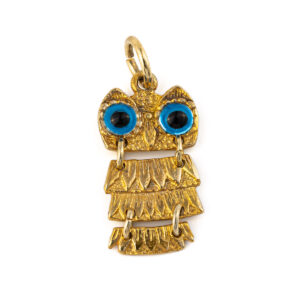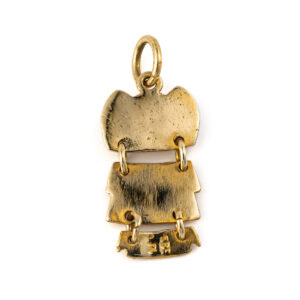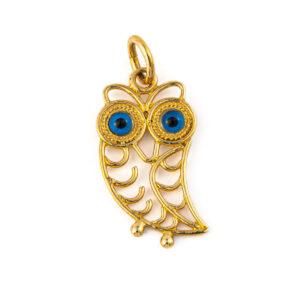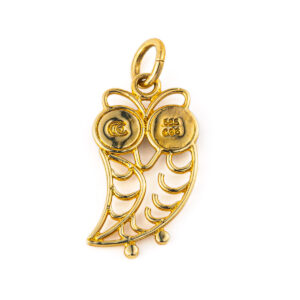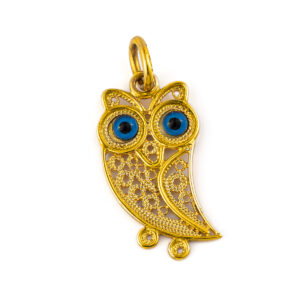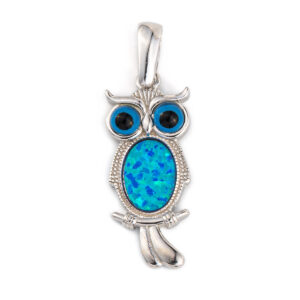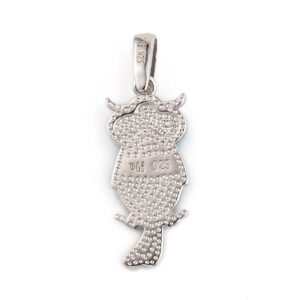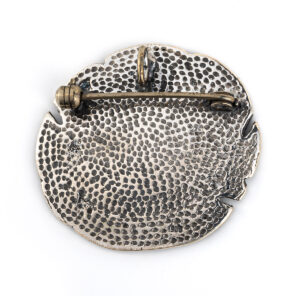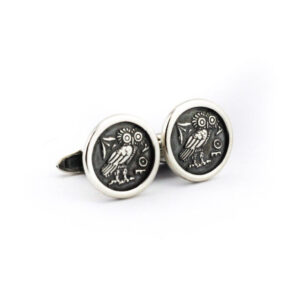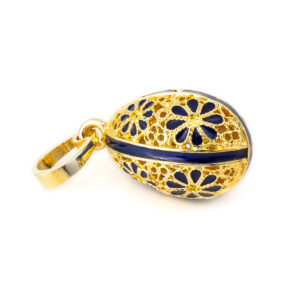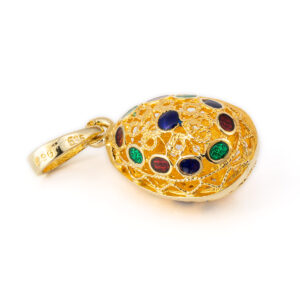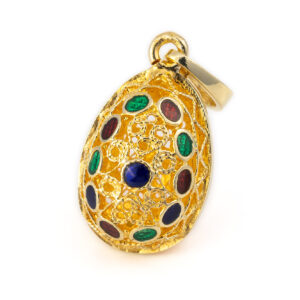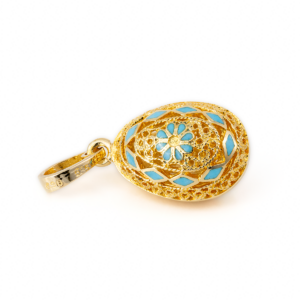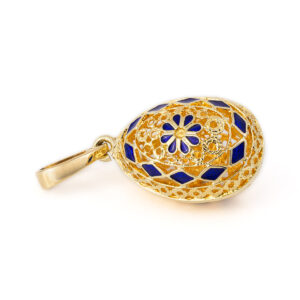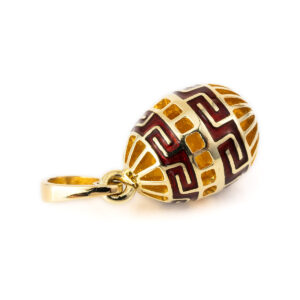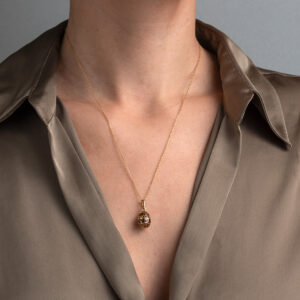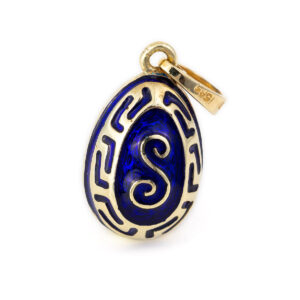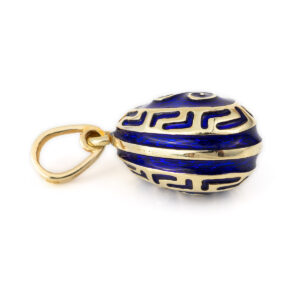Δερμάτινο Βραχιόλι με Κουκουβάγια – Ασήμι 925
Sterling Silver bracelet with genuine leather.
This bracelet comes in a beautiful box.
Made in 925⁰ sterling silver.
Handmade item.
Κολιέ με Μενταγιόν Αυγό – Ασήμι 925
The pendant is embellished with a fine filigree and enamel in Faberge style.
Made of 925 sterling silver.
Handmade in Greece.
The chain shown is included.
Filigree is a delicate kind of jewellery metalwork, made with tiny beads or twisted threads, or both in combination, soldered together or to the surface of an object of the same metal and arranged in artistic motifs. The art of filigree dates back to ancient history. The first of the found jewelry in this technique have been found in Mesopotamia and dates to thousands of years BC. In the ancient world and particularly in Asia Minor, this art grew were at the highest level.
Fabergé egg is a jeweled egg created by the House of Fabergé, in St. Petersburg, Imperial Russia. Virtually all were manufactured under the supervision of Peter Carl Fabergé between 1885 and 1917,[citation needed] the most famous being the 50 “Imperial” eggs, 43 of which survive, made for the Russian Tsars Alexander III and Nicholas II as Easter gifts for their wives and mothers. The first Fabergé egg was crafted for Tsar Alexander III, who had decided to give his wife, the Empress Maria Feodorovna, an Easter egg in 1885. Peter Carl Fabergé was a Russian jeweller best known for the famous Fabergé eggs made in the style of genuine Easter eggs, using precious metals and gemstones. He’s the founder of the famous jewelry legacy House of Fabergé.
Κολιέ με Μενταγιόν Αυγό – Ασήμι 925
The pendant is embellished with a fine filigree and enamel in Faberge style.
Made of 925 sterling silver.
Handmade in Greece.
The chain shown is included.
Filigree is a delicate kind of jewellery metalwork, made with tiny beads or twisted threads, or both in combination, soldered together or to the surface of an object of the same metal and arranged in artistic motifs. The art of filigree dates back to ancient history. The first of the found jewelry in this technique have been found in Mesopotamia and dates to thousands of years BC. In the ancient world and particularly in Asia Minor, this art grew were at the highest level.
Fabergé egg is a jeweled egg created by the House of Fabergé, in St. Petersburg, Imperial Russia. Virtually all were manufactured under the supervision of Peter Carl Fabergé between 1885 and 1917,[citation needed] the most famous being the 50 “Imperial” eggs, 43 of which survive, made for the Russian Tsars Alexander III and Nicholas II as Easter gifts for their wives and mothers. The first Fabergé egg was crafted for Tsar Alexander III, who had decided to give his wife, the Empress Maria Feodorovna, an Easter egg in 1885. Peter Carl Fabergé was a Russian jeweller best known for the famous Fabergé eggs made in the style of genuine Easter eggs, using precious metals and gemstones. He’s the founder of the famous jewelry legacy House of Fabergé.
Κολιέ με Μενταγιόν Αυγό – Ασήμι 925
The pendant is embellished with a fine filigree and enamel in Faberge style.
Made of 925 sterling silver.
Handmade in Greece.
The chain shown is included.
Filigree is a delicate kind of jewellery metalwork, made with tiny beads or twisted threads, or both in combination, soldered together or to the surface of an object of the same metal and arranged in artistic motifs. The art of filigree dates back to ancient history. The first of the found jewelry in this technique have been found in Mesopotamia and dates to thousands of years BC. In the ancient world and particularly in Asia Minor, this art grew were at the highest level.
Fabergé egg is a jeweled egg created by the House of Fabergé, in St. Petersburg, Imperial Russia. Virtually all were manufactured under the supervision of Peter Carl Fabergé between 1885 and 1917,[citation needed] the most famous being the 50 “Imperial” eggs, 43 of which survive, made for the Russian Tsars Alexander III and Nicholas II as Easter gifts for their wives and mothers. The first Fabergé egg was crafted for Tsar Alexander III, who had decided to give his wife, the Empress Maria Feodorovna, an Easter egg in 1885. Peter Carl Fabergé was a Russian jeweller best known for the famous Fabergé eggs made in the style of genuine Easter eggs, using precious metals and gemstones. He’s the founder of the famous jewelry legacy House of Fabergé.
Κολιέ με Μενταγιόν Αυγό – Ασήμι 925 Επιχρυσωμένο
The pendant is embellished with a fine filigree and enamel in Faberge style.
Made of 925 sterling silver and gold plated.
Handmade in Greece.
The chain shown is included.
Filigree is a delicate kind of jewellery metalwork, made with tiny beads or twisted threads, or both in combination, soldered together or to the surface of an object of the same metal and arranged in artistic motifs. The art of filigree dates back to ancient history. The first of the found jewelry in this technique have been found in Mesopotamia and dates to thousands of years BC. In the ancient world and particularly in Asia Minor, this art grew were at the highest level.
Fabergé egg is a jeweled egg created by the House of Fabergé, in St. Petersburg, Imperial Russia. Virtually all were manufactured under the supervision of Peter Carl Fabergé between 1885 and 1917,[citation needed] the most famous being the 50 “Imperial” eggs, 43 of which survive, made for the Russian Tsars Alexander III and Nicholas II as Easter gifts for their wives and mothers. The first Fabergé egg was crafted for Tsar Alexander III, who had decided to give his wife, the Empress Maria Feodorovna, an Easter egg in 1885. Peter Carl Fabergé was a Russian jeweller best known for the famous Fabergé eggs made in the style of genuine Easter eggs, using precious metals and gemstones. He’s the founder of the famous jewelry legacy House of Fabergé.
Κολιέ με Μενταγιόν Αυγό – Ασήμι 925 Επιχρυσωμένο
The pendant is embellished with a fine filigree and enamel in Faberge style.
Made of 925 sterling silver and gold plated.
Handmade in Greece.
The chain shown is included.
Filigree is a delicate kind of jewellery metalwork, made with tiny beads or twisted threads, or both in combination, soldered together or to the surface of an object of the same metal and arranged in artistic motifs. The art of filigree dates back to ancient history. The first of the found jewelry in this technique have been found in Mesopotamia and dates to thousands of years BC. In the ancient world and particularly in Asia Minor, this art grew were at the highest level.
Fabergé egg is a jeweled egg created by the House of Fabergé, in St. Petersburg, Imperial Russia. Virtually all were manufactured under the supervision of Peter Carl Fabergé between 1885 and 1917,[citation needed] the most famous being the 50 “Imperial” eggs, 43 of which survive, made for the Russian Tsars Alexander III and Nicholas II as Easter gifts for their wives and mothers. The first Fabergé egg was crafted for Tsar Alexander III, who had decided to give his wife, the Empress Maria Feodorovna, an Easter egg in 1885. Peter Carl Fabergé was a Russian jeweller best known for the famous Fabergé eggs made in the style of genuine Easter eggs, using precious metals and gemstones. He’s the founder of the famous jewelry legacy House of Fabergé.
Κολιέ με Μενταγιόν Αυγό – Ασήμι 925 Επιχρυσωμένο
The pendant is embellished with a fine filigree and enamel in Faberge style.
Made of 925 sterling silver and gold plated.
Handmade in Greece.
The chain shown is included.
Filigree is a delicate kind of jewellery metalwork, made with tiny beads or twisted threads, or both in combination, soldered together or to the surface of an object of the same metal and arranged in artistic motifs. The art of filigree dates back to ancient history. The first of the found jewelry in this technique have been found in Mesopotamia and dates to thousands of years BC. In the ancient world and particularly in Asia Minor, this art grew were at the highest level.
Fabergé egg is a jeweled egg created by the House of Fabergé, in St. Petersburg, Imperial Russia. Virtually all were manufactured under the supervision of Peter Carl Fabergé between 1885 and 1917,[citation needed] the most famous being the 50 “Imperial” eggs, 43 of which survive, made for the Russian Tsars Alexander III and Nicholas II as Easter gifts for their wives and mothers. The first Fabergé egg was crafted for Tsar Alexander III, who had decided to give his wife, the Empress Maria Feodorovna, an Easter egg in 1885. Peter Carl Fabergé was a Russian jeweller best known for the famous Fabergé eggs made in the style of genuine Easter eggs, using precious metals and gemstones. He’s the founder of the famous jewelry legacy House of Fabergé.
Κολιέ με Μενταγιόν Αυγό – Ασήμι 925
The pendant is embellished with a fine filigree and enamel in Faberge style.
Made of 925 sterling silver.
Handmade in Greece.
The chain shown is included.
Filigree is a delicate kind of jewellery metalwork, made with tiny beads or twisted threads, or both in combination, soldered together or to the surface of an object of the same metal and arranged in artistic motifs. The art of filigree dates back to ancient history. The first of the found jewelry in this technique have been found in Mesopotamia and dates to thousands of years BC. In the ancient world and particularly in Asia Minor, this art grew were at the highest level.
Fabergé egg is a jeweled egg created by the House of Fabergé, in St. Petersburg, Imperial Russia. Virtually all were manufactured under the supervision of Peter Carl Fabergé between 1885 and 1917,[citation needed] the most famous being the 50 “Imperial” eggs, 43 of which survive, made for the Russian Tsars Alexander III and Nicholas II as Easter gifts for their wives and mothers. The first Fabergé egg was crafted for Tsar Alexander III, who had decided to give his wife, the Empress Maria Feodorovna, an Easter egg in 1885. Peter Carl Fabergé was a Russian jeweller best known for the famous Fabergé eggs made in the style of genuine Easter eggs, using precious metals and gemstones. He’s the founder of the famous jewelry legacy House of Fabergé.
Κολιέ με Μενταγιόν Αυγό – Ασήμι 925
The pendant is embellished with a fine filigree and enamel in Faberge style.
Made of 925 sterling silver.
Handmade in Greece.
The chain shown is included.
Filigree is a delicate kind of jewellery metalwork, made with tiny beads or twisted threads, or both in combination, soldered together or to the surface of an object of the same metal and arranged in artistic motifs. The art of filigree dates back to ancient history. The first of the found jewelry in this technique have been found in Mesopotamia and dates to thousands of years BC. In the ancient world and particularly in Asia Minor, this art grew were at the highest level.
Fabergé egg is a jeweled egg created by the House of Fabergé, in St. Petersburg, Imperial Russia. Virtually all were manufactured under the supervision of Peter Carl Fabergé between 1885 and 1917,[citation needed] the most famous being the 50 “Imperial” eggs, 43 of which survive, made for the Russian Tsars Alexander III and Nicholas II as Easter gifts for their wives and mothers. The first Fabergé egg was crafted for Tsar Alexander III, who had decided to give his wife, the Empress Maria Feodorovna, an Easter egg in 1885. Peter Carl Fabergé was a Russian jeweller best known for the famous Fabergé eggs made in the style of genuine Easter eggs, using precious metals and gemstones. He’s the founder of the famous jewelry legacy House of Fabergé.
Κολιέ με Μενταγιόν Αυγό – Ασήμι 925 Επιχρυσωμένο
The pendant is embellished with a fine filigree and enamel in Faberge style.
Made of 925 sterling silver and gold plated.
Handmade in Greece.
The chain shown is included.
Filigree is a delicate kind of jewellery metalwork, made with tiny beads or twisted threads, or both in combination, soldered together or to the surface of an object of the same metal and arranged in artistic motifs. The art of filigree dates back to ancient history. The first of the found jewelry in this technique have been found in Mesopotamia and dates to thousands of years BC. In the ancient world and particularly in Asia Minor, this art grew were at the highest level.
Fabergé egg is a jeweled egg created by the House of Fabergé, in St. Petersburg, Imperial Russia. Virtually all were manufactured under the supervision of Peter Carl Fabergé between 1885 and 1917,[citation needed] the most famous being the 50 “Imperial” eggs, 43 of which survive, made for the Russian Tsars Alexander III and Nicholas II as Easter gifts for their wives and mothers. The first Fabergé egg was crafted for Tsar Alexander III, who had decided to give his wife, the Empress Maria Feodorovna, an Easter egg in 1885. Peter Carl Fabergé was a Russian jeweller best known for the famous Fabergé eggs made in the style of genuine Easter eggs, using precious metals and gemstones. He’s the founder of the famous jewelry legacy House of Fabergé.
Κολιέ με Μενταγιόν Αυγό – Ασήμι 925
The pendant is embellished with a fine filigree and enamel in Faberge style.
Made of 925 sterling silver.
Handmade in Greece.
The chain shown is included.
Filigree is a delicate kind of jewellery metalwork, made with tiny beads or twisted threads, or both in combination, soldered together or to the surface of an object of the same metal and arranged in artistic motifs. The art of filigree dates back to ancient history. The first of the found jewelry in this technique have been found in Mesopotamia and dates to thousands of years BC. In the ancient world and particularly in Asia Minor, this art grew were at the highest level.
Fabergé egg is a jeweled egg created by the House of Fabergé, in St. Petersburg, Imperial Russia. Virtually all were manufactured under the supervision of Peter Carl Fabergé between 1885 and 1917,[citation needed] the most famous being the 50 “Imperial” eggs, 43 of which survive, made for the Russian Tsars Alexander III and Nicholas II as Easter gifts for their wives and mothers. The first Fabergé egg was crafted for Tsar Alexander III, who had decided to give his wife, the Empress Maria Feodorovna, an Easter egg in 1885. Peter Carl Fabergé was a Russian jeweller best known for the famous Fabergé eggs made in the style of genuine Easter eggs, using precious metals and gemstones. He’s the founder of the famous jewelry legacy House of Fabergé.
Κολιέ με Μενταγιόν Αυγό – Ασήμι 925
The pendant is embellished with a fine filigree and enamel in Faberge style.
Made of 925 sterling silver.
Handmade in Greece.
The chain shown is included.
Filigree is a delicate kind of jewellery metalwork, made with tiny beads or twisted threads, or both in combination, soldered together or to the surface of an object of the same metal and arranged in artistic motifs. The art of filigree dates back to ancient history. The first of the found jewelry in this technique have been found in Mesopotamia and dates to thousands of years BC. In the ancient world and particularly in Asia Minor, this art grew were at the highest level.
Fabergé egg is a jeweled egg created by the House of Fabergé, in St. Petersburg, Imperial Russia. Virtually all were manufactured under the supervision of Peter Carl Fabergé between 1885 and 1917,[citation needed] the most famous being the 50 “Imperial” eggs, 43 of which survive, made for the Russian Tsars Alexander III and Nicholas II as Easter gifts for their wives and mothers. The first Fabergé egg was crafted for Tsar Alexander III, who had decided to give his wife, the Empress Maria Feodorovna, an Easter egg in 1885. Peter Carl Fabergé was a Russian jeweller best known for the famous Fabergé eggs made in the style of genuine Easter eggs, using precious metals and gemstones. He’s the founder of the famous jewelry legacy House of Fabergé.
Κολιέ με Μενταγιόν Αυγό – Ασήμι 925
The pendant is embellished with a fine filigree and enamel in Faberge style.
Made of 925 sterling silver.
Handmade in Greece.
The chain shown is included.
Filigree is a delicate kind of jewellery metalwork, made with tiny beads or twisted threads, or both in combination, soldered together or to the surface of an object of the same metal and arranged in artistic motifs. The art of filigree dates back to ancient history. The first of the found jewelry in this technique have been found in Mesopotamia and dates to thousands of years BC. In the ancient world and particularly in Asia Minor, this art grew were at the highest level.
Fabergé egg is a jeweled egg created by the House of Fabergé, in St. Petersburg, Imperial Russia. Virtually all were manufactured under the supervision of Peter Carl Fabergé between 1885 and 1917,[citation needed] the most famous being the 50 “Imperial” eggs, 43 of which survive, made for the Russian Tsars Alexander III and Nicholas II as Easter gifts for their wives and mothers. The first Fabergé egg was crafted for Tsar Alexander III, who had decided to give his wife, the Empress Maria Feodorovna, an Easter egg in 1885. Peter Carl Fabergé was a Russian jeweller best known for the famous Fabergé eggs made in the style of genuine Easter eggs, using precious metals and gemstones. He’s the founder of the famous jewelry legacy House of Fabergé.
Κολιέ με Μενταγιόν Αυγό – Ασήμι 925
The pendant is embellished with a fine filigree and enamel in Faberge style.
Made of 925 sterling silver.
Handmade in Greece.
The chain shown is included.
Filigree is a delicate kind of jewellery metalwork, made with tiny beads or twisted threads, or both in combination, soldered together or to the surface of an object of the same metal and arranged in artistic motifs. The art of filigree dates back to ancient history. The first of the found jewelry in this technique have been found in Mesopotamia and dates to thousands of years BC. In the ancient world and particularly in Asia Minor, this art grew were at the highest level.
Fabergé egg is a jeweled egg created by the House of Fabergé, in St. Petersburg, Imperial Russia. Virtually all were manufactured under the supervision of Peter Carl Fabergé between 1885 and 1917,[citation needed] the most famous being the 50 “Imperial” eggs, 43 of which survive, made for the Russian Tsars Alexander III and Nicholas II as Easter gifts for their wives and mothers. The first Fabergé egg was crafted for Tsar Alexander III, who had decided to give his wife, the Empress Maria Feodorovna, an Easter egg in 1885. Peter Carl Fabergé was a Russian jeweller best known for the famous Fabergé eggs made in the style of genuine Easter eggs, using precious metals and gemstones. He’s the founder of the famous jewelry legacy House of Fabergé.
Κολιέ με Μενταγιόν Αυγό – Ασήμι 925
The pendant is embellished with a fine filigree and enamel in Faberge style.
Made of 925 sterling silver.
Handmade in Greece.
The chain shown is included.
Filigree is a delicate kind of jewellery metalwork, made with tiny beads or twisted threads, or both in combination, soldered together or to the surface of an object of the same metal and arranged in artistic motifs. The art of filigree dates back to ancient history. The first of the found jewelry in this technique have been found in Mesopotamia and dates to thousands of years BC. In the ancient world and particularly in Asia Minor, this art grew were at the highest level.
Fabergé egg is a jeweled egg created by the House of Fabergé, in St. Petersburg, Imperial Russia. Virtually all were manufactured under the supervision of Peter Carl Fabergé between 1885 and 1917,[citation needed] the most famous being the 50 “Imperial” eggs, 43 of which survive, made for the Russian Tsars Alexander III and Nicholas II as Easter gifts for their wives and mothers. The first Fabergé egg was crafted for Tsar Alexander III, who had decided to give his wife, the Empress Maria Feodorovna, an Easter egg in 1885. Peter Carl Fabergé was a Russian jeweller best known for the famous Fabergé eggs made in the style of genuine Easter eggs, using precious metals and gemstones. He’s the founder of the famous jewelry legacy House of Fabergé.
Κολιέ με Μενταγιόν Αυγό – Ασήμι 925
The pendant is embellished with a fine filigree and enamel in Faberge style.
Made of 925 sterling silver.
Handmade in Greece.
The chain shown is included.
Filigree is a delicate kind of jewellery metalwork, made with tiny beads or twisted threads, or both in combination, soldered together or to the surface of an object of the same metal and arranged in artistic motifs. The art of filigree dates back to ancient history. The first of the found jewelry in this technique have been found in Mesopotamia and dates to thousands of years BC. In the ancient world and particularly in Asia Minor, this art grew were at the highest level.
Fabergé egg is a jeweled egg created by the House of Fabergé, in St. Petersburg, Imperial Russia. Virtually all were manufactured under the supervision of Peter Carl Fabergé between 1885 and 1917,[citation needed] the most famous being the 50 “Imperial” eggs, 43 of which survive, made for the Russian Tsars Alexander III and Nicholas II as Easter gifts for their wives and mothers. The first Fabergé egg was crafted for Tsar Alexander III, who had decided to give his wife, the Empress Maria Feodorovna, an Easter egg in 1885. Peter Carl Fabergé was a Russian jeweller best known for the famous Fabergé eggs made in the style of genuine Easter eggs, using precious metals and gemstones. He’s the founder of the famous jewelry legacy House of Fabergé.
Κολιέ με Μενταγιόν Αυγό – Ασήμι 925
The pendant is embellished with a fine filigree and multicolor enamel in Faberge style.
Made of 925 sterling silver.
Handmade in Greece.
The chain shown is included.
Filigree is a delicate kind of jewellery metalwork, made with tiny beads or twisted threads, or both in combination, soldered together or to the surface of an object of the same metal and arranged in artistic motifs. The art of filigree dates back to ancient history. The first of the found jewelry in this technique have been found in Mesopotamia and dates to thousands of years BC. In the ancient world and particularly in Asia Minor, this art grew were at the highest level.
Fabergé egg is a jeweled egg created by the House of Fabergé, in St. Petersburg, Imperial Russia. Virtually all were manufactured under the supervision of Peter Carl Fabergé between 1885 and 1917,[citation needed] the most famous being the 50 “Imperial” eggs, 43 of which survive, made for the Russian Tsars Alexander III and Nicholas II as Easter gifts for their wives and mothers. The first Fabergé egg was crafted for Tsar Alexander III, who had decided to give his wife, the Empress Maria Feodorovna, an Easter egg in 1885. Peter Carl Fabergé was a Russian jeweller best known for the famous Fabergé eggs made in the style of genuine Easter eggs, using precious metals and gemstones. He’s the founder of the famous jewelry legacy House of Fabergé.
Κολιέ με Μενταγιόν Αυγό – Ασήμι 925
The pendant is embellished with a fine filigree and blue enamel in Faberge style.
Made of 925 sterling silver.
Handmade in Greece.
The chain shown is included.
Filigree is a delicate kind of jewellery metalwork, made with tiny beads or twisted threads, or both in combination, soldered together or to the surface of an object of the same metal and arranged in artistic motifs. The art of filigree dates back to ancient history. The first of the found jewelry in this technique have been found in Mesopotamia and dates to thousands of years BC. In the ancient world and particularly in Asia Minor, this art grew were at the highest level.
Fabergé egg is a jeweled egg created by the House of Fabergé, in St. Petersburg, Imperial Russia. Virtually all were manufactured under the supervision of Peter Carl Fabergé between 1885 and 1917,[citation needed] the most famous being the 50 “Imperial” eggs, 43 of which survive, made for the Russian Tsars Alexander III and Nicholas II as Easter gifts for their wives and mothers. The first Fabergé egg was crafted for Tsar Alexander III, who had decided to give his wife, the Empress Maria Feodorovna, an Easter egg in 1885. Peter Carl Fabergé was a Russian jeweller best known for the famous Fabergé eggs made in the style of genuine Easter eggs, using precious metals and gemstones. He’s the founder of the famous jewelry legacy House of Fabergé.
Κολιέ Κουκουβάγια – Ασήμι 925 Επιχρυσωμένο με Ζιργκόν
Κατασκευασμένο από ασήμι 925.
Στην ελληνική μυθολογία, μια μικρή κουκουβάγια παραδοσιακά αντιπροσωπεύει ή συνοδεύει την Αθηνά, Θεά της σοφίας. Λόγω αυτής της συσχέτισης, το πουλί – που συχνά αναφέρεται ως «κουκουβάγια της Αθηνάς» έχει χρησιμοποιηθεί ως σύμβολο γνώσης, σοφίας, οξυδέρκειας και ευρυμάθειας.
Χειροποίητο ελληνικό κόσμημα.
Κολιέ Κουκουβάγια με Λευκά Ζιργκόν – Ασήμι 925 Επιχρυσωμένο
Κατασκευασμένο από ασήμι 925.
Στην ελληνική μυθολογία, μια μικρή κουκουβάγια παραδοσιακά αντιπροσωπεύει ή συνοδεύει την Αθηνά, Θεά της σοφίας. Λόγω αυτής της συσχέτισης, το πουλί – που συχνά αναφέρεται ως «κουκουβάγια της Αθηνάς» έχει χρησιμοποιηθεί ως σύμβολο γνώσης, σοφίας, οξυδέρκειας και ευρυμάθειας.
Χειροποίητο ελληνικό κόσμημα.
Ξύλινο Κάδρο 15X15cm με μπρούτζινη φιγούρα – Κουκουβάγια
Ορειχάλκινα σχήματα σε ξύλινο πλαίσιο.
Χειροποίητο αντικείμενο.
Owl Coin Cufflinks – 925 Sterling Silver
Made of 925⁰ sterling silver.
Owl of Athena
In Greek mythology, a little owl traditionally represents or accompanies Athena, the virgin goddess of wisdom. Because of such association, the bird – often referred to as the «owl of Athena» has been used as a symbol of knowledge, wisdom, perspicacity and erudition.
Μενταγιόν Κουκουβάγια – Ασήμι 925 Επιχρυσωμένο
Κατασκευασμένο από επιχρυσωμένο ασήμι 925.
Στην ελληνική μυθολογία, μια μικρή κουκουβάγια παραδοσιακά αντιπροσωπεύει ή συνοδεύει την Αθηνά, Θεά της σοφίας. Λόγω αυτής της συσχέτισης, το πουλί – που συχνά αναφέρεται ως «κουκουβάγια της Αθηνάς» έχει χρησιμοποιηθεί ως σύμβολο γνώσης, σοφίας, οξυδέρκειας και ευρυμάθειας.
Χειροποίητο ελληνικό κόσμημα.
Σκουλαρίκια Κουκουβάγια – Ασήμι 925 Επιχρυσωμένο
Κατασκευασμένο από επιχρυσωμένο ασήμι 925.
Στην ελληνική μυθολογία, μια μικρή κουκουβάγια παραδοσιακά αντιπροσωπεύει ή συνοδεύει την Αθηνά, Θεά της σοφίας. Λόγω αυτής της συσχέτισης, το πουλί – που συχνά αναφέρεται ως «κουκουβάγια της Αθηνάς» έχει χρησιμοποιηθεί ως σύμβολο γνώσης, σοφίας, οξυδέρκειας και ευρυμάθειας.
Χειροποίητο ελληνικό κόσμημα.
Διακοσμητικό Ξύλινο Κάδρο 20X30cm – Κουκουβάγια Ορείχαλκος
Ορειχάλκινα σχήματα σε ξύλινο πλαίσιο.
Χειροποίητο αντικείμενο.
Διακοσμητικό Ξύλινο Κάδρο 25X25 cm – Κουκουβάγια Ορείχαλκος
Ορειχάλκινα σχήματα σε ξύλινο πλαίσιο.
Χειροποίητο αντικείμενο.
Κολιέ Μενταγιόν Αυγό – Ασήμι 925 Επιχρυσωμένο
Κατασκευασμένο από επιχρυσωμένο ασήμι 925.
Το μενταγιόν είναι διακοσμημένο με λεπτό φιλιγκράν και μπλε σμάλτο σε στυλ Faberge.
Περιλαμβάνεται η αλυσίδα που φαίνεται.
Χρησιμοποιείται ως γούρι ή ως μενταγιόν. Πάρτε ένα όμορφο δώρο εμπνευσμένο από τη μαγευτική τέχνη του Fabergé!
Χειροποίητο ελληνικό κόσμημα.
Κολιέ Μενταγιόν Αυγό με Μαίανδρο – Ασήμι 925 Επιχρυσωμένο
Κατασκευασμένο από επιχρυσωμένο ασήμι 925.
Το μενταγιόν είναι διακοσμημένο με λεπτό φιλιγκράν και τιρκουάζ ή μπλε σμάλτο σε στυλ Faberge.
Περιλαμβάνεται η αλυσίδα που φαίνεται.
Χρησιμοποιείται ως γούρι ή ως μενταγιόν. Πάρτε ένα όμορφο δώρο εμπνευσμένο από τη μαγευτική τέχνη του Fabergé!
Χειροποίητο ελληνικό κόσμημα.
Κολιέ Μενταγιόν Αυγό με Κόκκινο Μαίανδρο – Ασήμι 925 Επιχρυσωμένο
Κατασκευασμένο από επιχρυσωμένο ασήμι 925.
Το μενταγιόν είναι διακοσμημένο με λεπτό φιλιγκράν και κόκκινο σμάλτο σε στυλ Faberge.
Περιλαμβάνεται η αλυσίδα που φαίνεται.
Χρησιμοποιείται ως γούρι ή ως μενταγιόν. Πάρτε ένα όμορφο δώρο εμπνευσμένο από τη μαγευτική τέχνη του Fabergé!
Χειροποίητο ελληνικό κόσμημα.
Μενταγιόν Κολιέ Αυγό – Ασήμι 925 Επιχρυσωμένο
Κατασκευασμένο από επιχρυσωμένο ασήμι 925.
Το μενταγιόν είναι διακοσμημένο με λεπτό φιλιγκράν και τιρκουάζ σμάλτο σε στυλ Faberge.
Περιλαμβάνεται η αλυσίδα που φαίνεται.
Χρησιμοποιείται ως γούρι ή ως μενταγιόν. Πάρτε ένα όμορφο δώρο εμπνευσμένο από τη μαγευτική τέχνη του Fabergé!
Χειροποίητο ελληνικό κόσμημα.
Κολιέ Μενταγιόν Αυγό με Μπλε και Τιρκουάζ – Ασήμι 925 Επιχρυσωμένο
Κατασκευασμένο από επιχρυσωμένο ασήμι 925.
Το μενταγιόν είναι διακοσμημένο με λεπτό φιλιγκράν και τιρκουάζ ή μπλε σμάλτο σε στυλ Faberge.
Περιλαμβάνεται η αλυσίδα που φαίνεται.
Χρησιμοποιείται ως γούρι ή ως μενταγιόν. Πάρτε ένα όμορφο δώρο εμπνευσμένο από τη μαγευτική τέχνη του Fabergé!
Χειροποίητο ελληνικό κόσμημα.
Κολιέ Μενταγιόν Αυγό – Ασήμι 925 Επιχρυσωμένο
Κατασκευασμένο από επιχρυσωμένο ασήμι 925.
Το μενταγιόν είναι διακοσμημένο με λεπτό φιλιγκράν και τιρκουάζ σμάλτο σε στυλ Faberge.
Περιλαμβάνεται η αλυσίδα που φαίνεται.
Χρησιμοποιείται ως γούρι ή ως μενταγιόν. Πάρτε ένα όμορφο δώρο εμπνευσμένο από τη μαγευτική τέχνη του Fabergé!
Χειροποίητο ελληνικό κόσμημα.
Αυγό Μενταγιόν Κολιέ με Σμάλτο – Ασήμι 925 Επιχρυσωμένο
Κατασκευασμένο από επιχρυσωμένο ασήμι 925.
Το μενταγιόν είναι διακοσμημένο με λεπτό φιλιγκράν και μπλε σμάλτο σε στυλ Faberge.
Περιλαμβάνεται η αλυσίδα που φαίνεται.
Χρησιμοποιείται ως γούρι ή ως μενταγιόν. Πάρτε ένα όμορφο δώρο εμπνευσμένο από τη μαγευτική τέχνη του Fabergé!
Χειροποίητο ελληνικό κόσμημα.
Μενταγιόν Κολιέ Αυγό με Σταυρό – Ασήμι 925 Επιχρυσωμένο
Κατασκευασμένο από επιχρυσωμένο ασήμι 925.
Το μενταγιόν είναι διακοσμημένο με λεπτό φιλιγκράν και τιρκουάζ σμάλτο σε στυλ Faberge.
Περιλαμβάνεται η αλυσίδα που φαίνεται.
Χρησιμοποιείται ως γούρι ή ως μενταγιόν. Πάρτε ένα όμορφο δώρο εμπνευσμένο από τη μαγευτική τέχνη του Fabergé!
Χειροποίητο ελληνικό κόσμημα.
Μενταγιόν Αυγό Rosette – Ασήμι 925 Επιχρυσωμένο
Κατασκευασμένο από επιχρυσωμένο ασήμι 925.
Το μενταγιόν είναι διακοσμημένο με λεπτό φιλιγκράν σε στυλ Faberge.
Περιλαμβάνεται η αλυσίδα που φαίνεται.
Χρησιμοποιείται ως γούρι ή ως μενταγιόν. Πάρτε ένα όμορφο δώρο εμπνευσμένο από τη μαγευτική τέχνη του Fabergé!
Χειροποίητο ελληνικό κόσμημα.
Μενταγιόν Αυγό με Μοτίβα – Ασήμι 925 Επιχρυσωμένο
Κατασκευασμένο από επιχρυσωμένο ασήμι 925.
Το μενταγιόν είναι διακοσμημένο με λεπτό φιλιγκράν και τιρκουάζ και μπλε σμάλτο σε στυλ Faberge.
Περιλαμβάνεται η αλυσίδα που φαίνεται.
Χρησιμοποιείται ως γούρι ή ως μενταγιόν. Πάρτε ένα όμορφο δώρο εμπνευσμένο από τη μαγευτική τέχνη του Fabergé!
Χειροποίητο ελληνικό κόσμημα.
Μενταγιόν Αυγό Τιρκουάζ και Μπλε – Ασήμι 925 Επιχρυσωμένο
Κατασκευασμένο από επιχρυσωμένο ασήμι 925.
Το μενταγιόν είναι διακοσμημένο με λεπτό φιλιγκράν και τιρκουάζ και μπλε σμάλτο σε στυλ Faberge.
Περιλαμβάνεται η αλυσίδα που φαίνεται.
Χρησιμοποιείται ως γούρι ή ως μενταγιόν. Πάρτε ένα όμορφο δώρο εμπνευσμένο από τη μαγευτική τέχνη του Fabergé!
Χειροποίητο ελληνικό κόσμημα.
Μενταγιόν Αυγό με Μπλε Σταυρό – Ασήμι 925 Επιχρυσωμένο
Κατασκευασμένο από επιχρυσωμένο ασήμι 925.
Το μενταγιόν είναι διακοσμημένο με λεπτό φιλιγκράν και μπλε σμάλτο σε στυλ Faberge.
Περιλαμβάνεται η αλυσίδα που φαίνεται.
Χρησιμοποιείται ως γούρι ή ως μενταγιόν. Πάρτε ένα όμορφο δώρο εμπνευσμένο από τη μαγευτική τέχνη του Fabergé!
Χειροποίητο ελληνικό κόσμημα.
Μενταγιόν Αυγό με Τιρκουάζ Λουλούδια – Ασήμι 925 Επιχρυσωμένο
Κατασκευασμένο από επιχρυσωμένο ασήμι 925.
Το μενταγιόν είναι διακοσμημένο με λεπτό φιλιγκράν και τιρκουάζ σμάλτο σε στυλ Faberge.
Περιλαμβάνεται η αλυσίδα που φαίνεται.
Χρησιμοποιείται ως γούρι ή ως μενταγιόν. Πάρτε ένα όμορφο δώρο εμπνευσμένο από τη μαγευτική τέχνη του Fabergé!
Χειροποίητο ελληνικό κόσμημα.
Μενταγιόν Αυγό με Μπλε Λουλούδια – Ασήμι 925 Επιχρυσωμένο
Κατασκευασμένο από επιχρυσωμένο ασήμι 925.
Το μενταγιόν είναι διακοσμημένο με λεπτό φιλιγκράν και μπλε σμάλτο σε στυλ Faberge.
Περιλαμβάνεται η αλυσίδα που φαίνεται.
Χρησιμοποιείται ως γούρι ή ως μενταγιόν. Πάρτε ένα όμορφο δώρο εμπνευσμένο από τη μαγευτική τέχνη του Fabergé!
Χειροποίητο ελληνικό κόσμημα.
Μενταγιόν Αυγό με Μπλε Μαίανδρο – Ασήμι 925 Επιχρυσωμένο
Κατασκευασμένο από επιχρυσωμένο ασήμι 925.
Το μενταγιόν είναι διακοσμημένο με λεπτό φιλιγκράν και μπλε σμάλτο σε στυλ Faberge.
Περιλαμβάνεται η αλυσίδα που φαίνεται.
Χρησιμοποιείται ως γούρι ή ως μενταγιόν. Πάρτε ένα όμορφο δώρο εμπνευσμένο από τη μαγευτική τέχνη του Fabergé!
Χειροποίητο ελληνικό κόσμημα.
Μενταγιόν Αυγό με Τιρκουάζ Μαίανδρο – Ασήμι 925 Επιχρυσωμένο
Κατασκευασμένο από επιχρυσωμένο ασήμι 925.
Το μενταγιόν είναι διακοσμημένο με λεπτό φιλιγκράν και τιρκουάζ σμάλτο σε στυλ Faberge.
Περιλαμβάνεται η αλυσίδα που φαίνεται.
Χρησιμοποιείται ως γούρι ή ως μενταγιόν. Πάρτε ένα όμορφο δώρο εμπνευσμένο από τη μαγευτική τέχνη του Fabergé!
Χειροποίητο ελληνικό κόσμημα.
Μενταγιόν με Κουκουβάγια – Χρυσό 14Κ
357,00€This pendant is inspired by the Ancient Greek jewels which represent the symbol of the Wisdom Owl.
Made in 14k gold.
Owl of Athena
In Greek mythology, a little owl traditionally represents or accompanies Athena, the virgin goddess of wisdom. Because of such association, the bird – often referred to as the «owl of Athena» has been used as a symbol of knowledge, wisdom, perspicacity and erudition.
Μενταγιόν με Κουκουβάγια – Χρυσό 14Κ
208,00€This pendant is inspired by the Ancient Greek jewels which represent the symbol of the Wisdom Owl.
Made in 14k gold.
Owl of Athena
In Greek mythology, a little owl traditionally represents or accompanies Athena, the virgin goddess of wisdom. Because of such association, the bird – often referred to as the «owl of Athena» has been used as a symbol of knowledge, wisdom, perspicacity and erudition.
Wisdom Owl Filigree Pendant – 14K Gold with Sapphire
210,00€ – 340,00€This pendant is inspired by the Ancient Greek jewels which represent the symbol of the Wisdom Owl.
Made in 14k gold.
Owl of Athena
In Greek mythology, a little owl traditionally represents or accompanies Athena, the virgin goddess of wisdom. Because of such association, the bird – often referred to as the «owl of Athena» has been used as a symbol of knowledge, wisdom, perspicacity and erudition.
Model is wearing size Small.
The chain shown is our 14K Gold Box Chain (not included).
Wisdom Owl Filigree Pendant – 14K Gold with Zircon
210,00€This pendant is inspired by the ancient Greek owl and embellished with a fine filigree. The owl’s eyes are decorated with zircons.
Made in 14k gold.
Owl of Athena
In Greek mythology, a little owl traditionally represents or accompanies Athena, the virgin goddess of wisdom. Because of such association, the bird – often referred to as the «owl of Athena» has been used as a symbol of knowledge, wisdom, perspicacity and erudition. As in all handmade items there may be small differences in weight and dimensions and this is what makes them unique and precious.
Μενταγιόν με Κουκουβάγια – Χρυσό 14Κ
340,00€This pendant is inspired by the Ancient Greek jewels which represent the symbol of the Wisdom Owl.
Made in 14k gold. Pendant is embellished with a fine filigree
Owl of Athena
In Greek mythology, a little owl traditionally represents or accompanies Athena, the virgin goddess of wisdom. Because of such association, the bird – often referred to as the «owl of Athena» has been used as a symbol of knowledge, wisdom, perspicacity and erudition.
14k Gold Owl Pendant with Blue Eyes
Made in 14k gold. As in all handmade items there may be small differences in weight and dimensions and this is what makes them unique and precious.
14k Gold Filigree Pendant – Wisdom Owl with Blue Eyes
340,00€Wisdom Owl Pendant embellished with a fine filigree.
Made in 14k gold. As in all handmade items there may be small differences in weight and dimensions and this is what makes them unique and precious.
Μενταγιόν με Κουκουβάγια – Χρυσό 14Κ
340,00€Wisdom Owl Pendant is embellished with a fine filigree.
Made in 14k gold.
14k Gold Filigree Wisdom Owl Pendant
210,00€Wisdom Owl Pendant embellished with a fine filigree.
Made in 14k gold.
Μενταγιόν με Κουκουβάγια – Ασήμι 925 και Όπαλ
This is a silver pendant representing the owl – the symbol of Athena. The pendant is decorated with blue opal.
Made in 925⁰ sterling silver
Handmade item.
Μενταγιόν με Κουκουβάγια – Ασήμι 925 και Όπαλ
This is a silver pendant representing the owl – the symbol of Athena. The pendant is decorated with blue opal.
Made in 925⁰ sterling silver
Handmade item.
Καρφίτσα Κουκουβάγια – Ασήμι 925
A beautiful brooch with the wisdom owl.
Made in 925⁰ sterling silver. Oxidized finish.
Handmade item.
Goddess Athena Wisdom Owl Cufflinks – Sterling Silver
A beautiful pair of cufflinks with the wisdom owl.
Made in 925⁰ sterling silver
Handmade item.
Goddess Athena and Owl – Athenian silver tetradrachm
Dracma was the currency used in Greece during several periods in its history. The tetradrachm was an Ancient Greek silver coin equivalent to fourdrachmae in Athens it replaced the earlier “heraldic” type of didrachms and it was in wide circulation from ca. 510 to ca. 38 BC. This coin belongs to the so-called “new style Athenian coins” minted between 166 and 64 B.C. and is considered one of the most popular ancient Greek coins which illustrate the portrait of Goddess Athena on the one side and the wisdom owl on the other. Athena is an ancient Greek goddess associated with wisdom, handicraft, and warfare. Athena was regarded as the patron and protectress of various cities across Greece, particularly the city of Athens, from which she most likely received her name. She’s usually shown in art wearing a helmet and holding a spear. Her major symbols include owls, olive trees, and snakes. Her temples were located atop the fortified Acropolis in the central part of the city. The Parthenon on the Athenian Acropolis is dedicated to her, along with numerous other temples and monuments. Her main festival in Athens was the Panathenaia, which was celebrated in midsummer and was the most important festival on the Athenian calendar. In the classical Olympian pantheon, Athena was regarded as the favorite daughter of Zeus. The owl traditionally accompanies Athena. Because of such association, the owl has been used as a symbol of knowledge and wisdom. The inscriptions contain the city’s “national” appellation (“ΑΘΕ», i.e. “of the Athenians”).
Filigree Egg Pendant with Flowers – 14k Gold and Blue Enamel
612,00€The pendant is embellished with a fine filigree and blue enamel in Faberge style.
Used as a charm or as a pendant.
Pick up a beautiful gift inspired by the majestic art of Fabergé!
Made in 14k yellow gold
Filigree is a delicate kind of jewellery metalwork, made with tiny beads or twisted threads, or both in combination, soldered together or to the surface of an object of the same metal and arranged in artistic motifs. The art of filigree dates back to ancient history. The first of the found jewelry in this technique have been found in Mesopotamia and dates to thousands of years BC. In the ancient world and particularly in Asia Minor, this art grew were at the highest level.
Rosette The rosette (rose) is a timeless jewel, symbol and amulet. The origin of the term is the Greek word for rose – rodon (ρόδον). Its use began in the Mycenaean era and continues as far as the 2nd millennia BC. The Mycenaean Rosette is a motif that was widespread throughout Mesopotamia, Egypt, Greece and other ancient civilizations. Rosette or Rodax was probably the most popular and favorite decorative element in Mycenaean era, classical antiquity and Byzantine times.
Fabergé egg is a jeweled egg created by the House of Fabergé, in St. Petersburg, Imperial Russia. Virtually all were manufactured under the supervision of Peter Carl Fabergé between 1885 and 1917,[citation needed] the most famous being the 50 “Imperial” eggs, 43 of which survive, made for the Russian Tsars Alexander III and Nicholas II as Easter gifts for their wives and mothers. The first Fabergé egg was crafted for Tsar Alexander III, who had decided to give his wife, the Empress Maria Feodorovna, an Easter egg in 1885. Peter Carl Fabergé was a Russian jeweller best known for the famous Fabergé eggs made in the style of genuine Easter eggs, using precious metals and gemstones. He’s the founder of the famous jewelry legacy House of Fabergé.
Filigree Egg Pendant with Spiral Motifs – 14k Gold
440,00€The pendant is embellished with a fine filigree.
Used as a charm or as a pendant.
Pick up a beautiful gift inspired by the majestic art of Fabergé!
Made in 14k yellow gold and enamel dots in various colors.
Filigree is a delicate kind of jewellery metalwork, made with tiny beads or twisted threads, or both in combination, soldered together or to the surface of an object of the same metal and arranged in artistic motifs. The art of filigree dates back to ancient history. The first of the found jewelry in this technique have been found in Mesopotamia and dates to thousands of years BC. In the ancient world and particularly in Asia Minor, this art grew were at the highest level.
Rosette The rosette (rose) is a timeless jewel, symbol and amulet. The origin of the term is the Greek word for rose – rodon (ρόδον). Its use began in the Mycenaean era and continues as far as the 2nd millennia BC. The Mycenaean Rosette is a motif that was widespread throughout Mesopotamia, Egypt, Greece and other ancient civilizations. Rosette or Rodax was probably the most popular and favorite decorative element in Mycenaean era, classical antiquity and Byzantine times.
Fabergé egg is a jeweled egg created by the House of Fabergé, in St. Petersburg, Imperial Russia. Virtually all were manufactured under the supervision of Peter Carl Fabergé between 1885 and 1917,[citation needed] the most famous being the 50 “Imperial” eggs, 43 of which survive, made for the Russian Tsars Alexander III and Nicholas II as Easter gifts for their wives and mothers. The first Fabergé egg was crafted for Tsar Alexander III, who had decided to give his wife, the Empress Maria Feodorovna, an Easter egg in 1885. Peter Carl Fabergé was a Russian jeweller best known for the famous Fabergé eggs made in the style of genuine Easter eggs, using precious metals and gemstones. He’s the founder of the famous jewelry legacy House of Fabergé.
Filigree Egg Pendant – 14k Gold and Turquoise Enamel
440,00€The pendant is embellished with a fine filigree and turquoise enamel.
Used as a charm or as a pendant.
Pick up a beautiful gift inspired by the majestic art of Fabergé!
Made in 14k yellow gold
Filigree is a delicate kind of jewellery metalwork, made with tiny beads or twisted threads, or both in combination, soldered together or to the surface of an object of the same metal and arranged in artistic motifs. The art of filigree dates back to ancient history. The first of the found jewelry in this technique have been found in Mesopotamia and dates to thousands of years BC. In the ancient world and particularly in Asia Minor, this art grew were at the highest level.
Rosette The rosette (rose) is a timeless jewel, symbol and amulet. The origin of the term is the Greek word for rose – rodon (ρόδον). Its use began in the Mycenaean era and continues as far as the 2nd millennia BC. The Mycenaean Rosette is a motif that was widespread throughout Mesopotamia, Egypt, Greece and other ancient civilizations. Rosette or Rodax was probably the most popular and favorite decorative element in Mycenaean era, classical antiquity and Byzantine times.
Fabergé egg is a jeweled egg created by the House of Fabergé, in St. Petersburg, Imperial Russia. Virtually all were manufactured under the supervision of Peter Carl Fabergé between 1885 and 1917,[citation needed] the most famous being the 50 “Imperial” eggs, 43 of which survive, made for the Russian Tsars Alexander III and Nicholas II as Easter gifts for their wives and mothers. The first Fabergé egg was crafted for Tsar Alexander III, who had decided to give his wife, the Empress Maria Feodorovna, an Easter egg in 1885. Peter Carl Fabergé was a Russian jeweller best known for the famous Fabergé eggs made in the style of genuine Easter eggs, using precious metals and gemstones. He’s the founder of the famous jewelry legacy House of Fabergé. (wikipedia)
Filigree Egg Pendant with Rosette Flower – 14k Gold and Turquoise Enamel
510,00€The pendant is embellished with a fine filigree and turquoise enamel.
Used as a charm or as a pendant.
Pick up a beautiful gift inspired by the majestic art of Fabergé!
Made in 14k yellow gold
Filigree is a delicate kind of jewellery metalwork, made with tiny beads or twisted threads, or both in combination, soldered together or to the surface of an object of the same metal and arranged in artistic motifs. The art of filigree dates back to ancient history. The first of the found jewelry in this technique have been found in Mesopotamia and dates to thousands of years BC. In the ancient world and particularly in Asia Minor, this art grew were at the highest level.
Rosette The rosette (rose) is a timeless jewel, symbol and amulet. The origin of the term is the Greek word for rose – rodon (ρόδον). Its use began in the Mycenaean era and continues as far as the 2nd millennia BC. The Mycenaean Rosette is a motif that was widespread throughout Mesopotamia, Egypt, Greece and other ancient civilizations. Rosette or Rodax was probably the most popular and favorite decorative element in Mycenaean era, classical antiquity and Byzantine times.
Fabergé egg is a jeweled egg created by the House of Fabergé, in St. Petersburg, Imperial Russia. Virtually all were manufactured under the supervision of Peter Carl Fabergé between 1885 and 1917,[citation needed] the most famous being the 50 “Imperial” eggs, 43 of which survive, made for the Russian Tsars Alexander III and Nicholas II as Easter gifts for their wives and mothers. The first Fabergé egg was crafted for Tsar Alexander III, who had decided to give his wife, the Empress Maria Feodorovna, an Easter egg in 1885. Peter Carl Fabergé was a Russian jeweller best known for the famous Fabergé eggs made in the style of genuine Easter eggs, using precious metals and gemstones. He’s the founder of the famous jewelry legacy House of Fabergé. (wikipedia)
As in all handmade items there may be small differences in weight and dimensions and this is what makes them unique and precious.
14k Gold and Blue enamel Filigree Egg Pendant with Rosette Flower
645,00€The pendant is embellished with a fine filigree and blue enamel in Faberge style.
Used as a charm or as a pendant.
Pick up a beautiful gift inspired by the majestic art of Fabergé!
Made in 14k yellow gold
Available with green or red or multi color or turquoise enamel
Filigree is a delicate kind of jewellery metalwork, made with tiny beads or twisted threads, or both in combination, soldered together or to the surface of an object of the same metal and arranged in artistic motifs. The art of filigree dates back to ancient history. The first of the found jewelry in this technique have been found in Mesopotamia and dates to thousands of years BC. In the ancient world and particularly in Asia Minor, this art grew were at the highest level.
Rosette The rosette (rose) is a timeless jewel, symbol and amulet. The origin of the term is the Greek word for rose – rodon (ρόδον). Its use began in the Mycenaean era and continues as far as the 2nd millennia BC. The Mycenaean Rosette is a motif that was widespread throughout Mesopotamia, Egypt, Greece and other ancient civilizations. Rosette or Rodax was probably the most popular and favorite decorative element in Mycenaean era, classical antiquity and Byzantine times.
Fabergé egg is a jeweled egg created by the House of Fabergé, in St. Petersburg, Imperial Russia. Virtually all were manufactured under the supervision of Peter Carl Fabergé between 1885 and 1917,[citation needed] the most famous being the 50 “Imperial” eggs, 43 of which survive, made for the Russian Tsars Alexander III and Nicholas II as Easter gifts for their wives and mothers. The first Fabergé egg was crafted for Tsar Alexander III, who had decided to give his wife, the Empress Maria Feodorovna, an Easter egg in 1885. Peter Carl Fabergé was a Russian jeweller best known for the famous Fabergé eggs made in the style of genuine Easter eggs, using precious metals and gemstones. He’s the founder of the famous jewelry legacy House of Fabergé. (wikipedia)
Filigree Egg Pendant – 14k Gold with Blue Enamel
730,00€The pendant is embellished with a fine filigree and blue enamel in Faberge style.
Used as a charm or as a pendant.
Pick up a beautiful gift inspired by the majestic art of Fabergé!
Made in 14k yellow gold
Available with green or red or multi color or turquoise enamel
Filigree is a delicate kind of jewellery metalwork, made with tiny beads or twisted threads, or both in combination, soldered together or to the surface of an object of the same metal and arranged in artistic motifs. The art of filigree dates back to ancient history. The first of the found jewelry in this technique have been found in Mesopotamia and dates to thousands of years BC. In the ancient world and particularly in Asia Minor, this art grew were at the highest level.
Fabergé egg is a jeweled egg created by the House of Fabergé, in St. Petersburg, Imperial Russia. Virtually all were manufactured under the supervision of Peter Carl Fabergé between 1885 and 1917,[citation needed] the most famous being the 50 “Imperial” eggs, 43 of which survive, made for the Russian Tsars Alexander III and Nicholas II as Easter gifts for their wives and mothers. The first Fabergé egg was crafted for Tsar Alexander III, who had decided to give his wife, the Empress Maria Feodorovna, an Easter egg in 1885. Peter Carl Fabergé was a Russian jeweller best known for the famous Fabergé eggs made in the style of genuine Easter eggs, using precious metals and gemstones. He’s the founder of the famous jewelry legacy House of Fabergé.
As in all handmade items there may be small differences in weight and dimensions and this is what makes them unique and precious.
Μενταγιόν Αυγό Φιλιγκράν με Λουλούδια – Χρυσός 14Κ και Τυρκουάζ Σμάλτο
612,00€ – 952,00€Το μενταγιόν είναι διακοσμημένο με λουλούδια σε στυλ Faberge.
Χρησιμοποιείται ως γούρι ή ως μενταγιόν.
Διαλέξτε ένα όμορφο δώρο εμπνευσμένο από τη μεγαλοπρεπή τέχνη της Fabergé!
Κατασκευασμένο από χρυσό 14 καρατίων και τυρκουάζ σμάλτο.
Η αλυσίδα που απεικονίζεται είναι η 14Κ Gourmet Χρυσή Αλυσίδα μας (δεν περιλαμβάνεται).
Η ροζέτα (τριαντάφυλλο) είναι ένα διαχρονικό κόσμημα, σύμβολο και φυλαχτό. Η προέλευση του όρου είναι η ελληνική λέξη για το τριαντάφυλλο – rodon (ρόδον). Η χρήση του ξεκίνησε στη μυκηναϊκή εποχή και συνεχίζεται μέχρι τη 2η χιλιετία π.Χ. Η μυκηναϊκή ρόδα είναι ένα μοτίβο που ήταν ευρέως διαδεδομένο σε όλη τη Μεσοποταμία, την Αίγυπτο, την Ελλάδα και άλλους αρχαίους πολιτισμούς. Η ροζέτα ή Ροδάξ ήταν ίσως το πιο δημοφιλές και αγαπημένο διακοσμητικό στοιχείο στη μυκηναϊκή εποχή, την κλασική αρχαιότητα και τους βυζαντινούς χρόνους.
Το αυγό Φαμπερζέ είναι ένα αυγό κοσμήμα που δημιουργήθηκε από τον οίκο Φαμπερζέ, στην Αγία Πετρούπολη της αυτοκρατορικής Ρωσίας. Σχεδόν όλα κατασκευάστηκαν υπό την επίβλεψη του Πέτερ Καρλ Φαμπερζέ μεταξύ 1885 και 1917,[παραπομπή απαιτείται] με πιο διάσημα τα 50 «αυτοκρατορικά» αυγά, 43 από τα οποία σώζονται, που κατασκευάστηκαν για τους Ρώσους τσάρους Αλέξανδρο Γ’ και Νικόλαο Β’ ως πασχαλινά δώρα για τις συζύγους και τις μητέρες τους. Το πρώτο αυγό Φαμπερζέ φιλοτεχνήθηκε για τον τσάρο Αλέξανδρο Γ΄, ο οποίος είχε αποφασίσει να χαρίσει στη σύζυγό του, την αυτοκράτειρα Μαρία Φεοντόροβνα, ένα πασχαλινό αυγό το 1885. Ο Peter Carl Fabergé ήταν ένας Ρώσος κοσμηματοπώλης, γνωστός κυρίως για τα περίφημα αυγά Fabergé που κατασκευάστηκαν στο στυλ των γνήσιων πασχαλινών αυγών, χρησιμοποιώντας πολύτιμα μέταλλα και πολύτιμους λίθους. Είναι ο ιδρυτής της διάσημης κληρονομιάς κοσμημάτων του οίκου Fabergé.
Όπως σε όλα τα χειροποίητα κοσμήματα μπορεί να υπάρχουν μικρές διαφορές στο βάρος και τις διαστάσεις και αυτό είναι που τα κάνει μοναδικά και πολύτιμα.
Μενταγιόν Αυγό Μαίανδρος – Χρυσό 14Κ και Κόκκινο Σμάλτο
765,00€Το μενταγιόν είναι διακοσμημένο με το σχέδιο του μαίανδρου.
Χρησιμοποιείται ως γούρι ή ως μενταγιόν.
Πάρτε ένα όμορφο δώρο εμπνευσμένο από τη μεγαλοπρεπή τέχνη της Fabergé!
Κατασκευασμένο από χρυσό 14 καρατίων και κόκκινο σμάλτο.
Διατίθεται με μπλε ή πράσινο ή τυρκουάζ σμάλτο
Το σχέδιο Μαίανδρου είναι ένα διακοσμητικό περίγραμμα που κατασκευάζεται από μια συνεχή γραμμή, η οποία διαμορφώνεται σε ένα επαναλαμβανόμενο μοτίβο. Ένα τέτοιο σχέδιο αποκαλείται επίσης σχέδιο ελληνικού κροσσού ή ελληνικού κλειδιού, αν και πρόκειται για σύγχρονες ονομασίες. Από τη μία πλευρά, το όνομα «μαιάνδρος» θυμίζει τη στριμμένη και στρεφόμενη διαδρομή του ποταμού Μαιάνδρου στη Μικρά Ασία, και από την άλλη πλευρά, όπως τόνισε ο Karl Kerenyi, «ο μαιάνδρος είναι το σχήμα ενός λαβύρινθου σε γραμμική μορφή» το νόημα είναι ότι αυτά δεν υπάρχει αρχή και να τελειώσει τέλος σε ορισμένες περιπτώσεις, έτσι ώστε να γίνει το σύμβολο της μακράς ζωής και της αιωνιότητας.
Το αυγό Fabergé είναι ένα αυγό κόσμημα που δημιουργήθηκε από τον οίκο Fabergé, στην Αγία Πετρούπολη της αυτοκρατορικής Ρωσίας. Σχεδόν όλα κατασκευάστηκαν υπό την επίβλεψη του Πέτερ Καρλ Φαμπερζέ μεταξύ 1885 και 1917,[παραπομπή απαιτείται] με πιο διάσημα τα 50 «αυτοκρατορικά» αυγά, 43 από τα οποία σώζονται, που κατασκευάστηκαν για τους Ρώσους τσάρους Αλέξανδρο Γ’ και Νικόλαο Β’ ως πασχαλινά δώρα για τις συζύγους και τις μητέρες τους. Το πρώτο αυγό Φαμπερζέ φιλοτεχνήθηκε για τον τσάρο Αλέξανδρο Γ΄, ο οποίος είχε αποφασίσει να χαρίσει στη σύζυγό του, την αυτοκράτειρα Μαρία Φεοντόροβνα, ένα πασχαλινό αυγό το 1885. Ο Peter Carl Fabergé ήταν ένας Ρώσος κοσμηματοπώλης, γνωστός κυρίως για τα περίφημα αυγά Fabergé που κατασκευάστηκαν στο στυλ των γνήσιων πασχαλινών αυγών, χρησιμοποιώντας πολύτιμα μέταλλα και πολύτιμους λίθους. Είναι ο ιδρυτής της διάσημης κληρονομιάς κοσμημάτων του οίκου Fabergé.
Όπως σε όλα τα χειροποίητα κοσμήματα, ενδέχεται να υπάρχουν μικρές διαφορές στο βάρος και τις διαστάσεις, γεγονός που τα καθιστά μοναδικά και πολύτιμα.
Μενταγιόν Αυγό με Μαιάνδρο – Χρυσός 14Κ και Μπλε Σμάλτο
730,00€Το μενταγιόν είναι διακοσμημένο με σχέδιο μαίανδρου.
Χρησιμοποιείται ως γούρι ή ως μενταγιόν.
Πάρτε ένα όμορφο δώρο εμπνευσμένο από τη μεγαλοπρεπή τέχνη της Fabergé!
Κατασκευασμένο από χρυσό 14 καρατίων και μπλε σμάλτο.
Διατίθεται με μπλε ή πράσινο ή κόκκινο σμάλτο.
Το αυγό Fabergé είναι ένα αυγό με κοσμήματα που δημιουργήθηκε από τον οίκο Fabergé, στην Αγία Πετρούπολη της αυτοκρατορικής Ρωσίας. Σχεδόν όλα κατασκευάστηκαν υπό την επίβλεψη του Πέτερ Καρλ Φαμπερζέ μεταξύ 1885 και 1917, με πιο διάσημα τα 50 «αυτοκρατορικά» αυγά, 43 από τα οποία σώζονται, που κατασκευάστηκαν για τους Ρώσους τσάρους Αλέξανδρο Γ’ και Νικόλαο Β’ ως πασχαλινά δώρα για τις συζύγους και τις μητέρες τους. Το πρώτο αυγό Φαμπερζέ φιλοτεχνήθηκε για τον τσάρο Αλέξανδρο Γ΄, ο οποίος είχε αποφασίσει να χαρίσει στη σύζυγό του, την αυτοκράτειρα Μαρία Φεοντόροβνα, ένα πασχαλινό αυγό το 1885. Ο Peter Carl Fabergé ήταν ένας Ρώσος κοσμηματοπώλης, γνωστός κυρίως για τα περίφημα αυγά Fabergé που κατασκευάστηκαν στο στυλ των γνήσιων πασχαλινών αυγών, χρησιμοποιώντας πολύτιμα μέταλλα και πολύτιμους λίθους. Είναι ο ιδρυτής της διάσημης κληρονομιάς κοσμημάτων του οίκου Fabergé.
Σχέδιο μαίανδρου, ένα από τα πιο ιστορικά σύμβολα του ελληνικού κόσμου, που ονομάζεται επίσης ελληνικό κλειδί και συμβολίζει τη μακροζωία και την αιωνιότητα. Το μοτίβο με τον Μαίανδρο χρησιμοποιούνταν στην αρχαιότητα για τη διακόσμηση της ζωφόρου των ναών.
Όπως σε όλα τα χειροποίητα αντικείμενα μπορεί να υπάρχουν μικρές διαφορές στο βάρος και τις διαστάσεις και αυτό είναι που τα κάνει μοναδικά και πολύτιμα.

